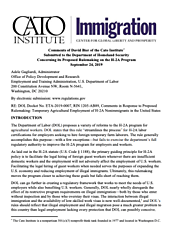The Department of Labor (DOL) proposes a variety of reforms to the H‑2A program for agricultural workers. DOL states that this rule “streamlines the process” for H‑2A labor certifications for employers seeking to hire foreign temporary farm laborers. The rule generally accomplishes this purpose—with a few exceptions—but fails to exercise the department’s full regulatory authority to improve the H‑2A program for employers and workers.
As laid out in the H‑2A statute (U.S. Code § 1188), the primary guiding principle for H‑2A policy is to facilitate the legal hiring of foreign guest workers whenever there are insufficient domestic workers and the employment will not adversely affect the employment of U.S. workers. Facilitating the legal hiring of guest workers when needed serves the purposes of expanding the U.S. economy and reducing employment of illegal immigrants. Ultimately, this rulemaking moves the program closer to achieving these goals but falls short of reaching them.
DOL can go further in creating a regulatory framework that works to meet the needs of U.S. employers while also benefiting U.S. workers. Generally, DOL nearly wholly disregards the effect of its restrictive program requirements on illegal immigration—both by those who enter without inspection and by those who overstay their visas. The interaction between illegal immigration and the availability of low-skilled work visas is now well-documented,i and DOL’s rules should reflect that illegal employment and illegal migration pose a much greater problem to this country than legal employment lacking every protection that DOL can possibly conceive.

This work is licensed under a Creative Commons Attribution-NonCommercial-ShareAlike 4.0 International License.

